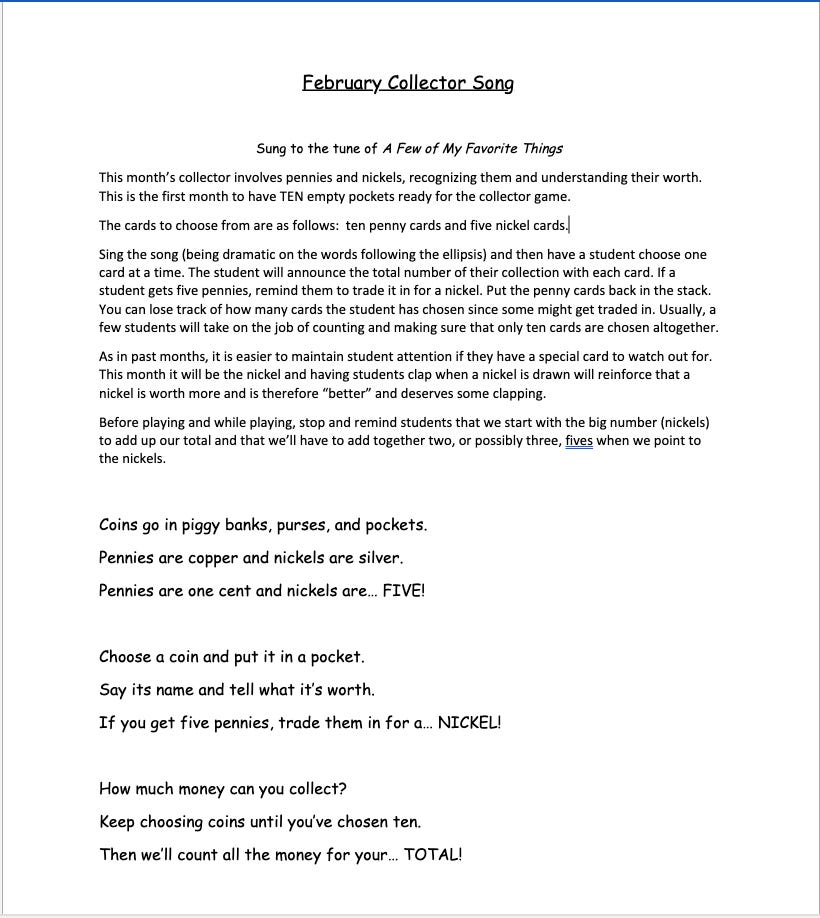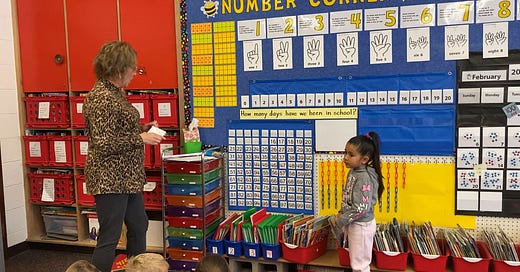Math? Say what? Yes, today I am doing a post on math. Some of you have asked if I am going to throw math into the mix of Busy Bee posts this school year and, while the general answer to that is no, I am going to give you this today for your consideration.
Why not include math in the Busy Bee Kindergarten posts? First and foremost, I follow a math program—Bridges—and it doesn’t make sense for me to share much about it. If you use it at your school, then you know what to do; if you don’t use it, then you probably wouldn’t be that interested. More important though, if I include math I will be in your inbox every day. And that would be horrible for all of us. I think I’ll just stick with the occasional math post, like this one.
We started using Bridges a couple years ago and I followed it almost to a tee the first year to learn its strengths and shortcomings. One thing I noticed, almost immediately, was that there wasn’t much addition and subtraction with equations. Not enough for students to really understand equations and become fluent with reading, writing, and solving them. That is why I started supplementing with my Fast Fact Factory. (If you click on this video and watch it, notice when I refer to and briefly zoom in the “collector game.”)
Another aspect of Bridges—and the related Number Corner daily activities like counting the school days and calendar—that bugged me was how many times we were supposed to introduce and teach a new activity and game that we then used just a couple of more times. It just doesn’t make sense to spend a lot of minutes explaining how to do an activity when those minutes should be devoted to actually doing the activity. So, I modified Number Corner by reducing the number of new activities per month and repeating the best ones instead. Oh, and I also modified the best ones and made them mo’ better—more fun, more engaging, and more worthy of their time on my daily schedule.
Basically, there are five Number Corner activities and I reduced that to three—counting the school days, a collector game, and calendar activities. The two I cut could easily be incorporated into our main math period lessons and activities, which means I was still being true to the Bridges program.
It took me all school year to modify and improve the monthly Number Corner collector games (so-called because the special helper gets to collect cards or items and do something with them). Each month, I tested the new activity for fun, effectiveness, and student engagement; revised it throughout the month if needed; and, then wrote the final product to share with all of you. Of course, I wrote a song for each month’s activity. My students had so much fun with each song and activity that I really had to challenge myself to come up with something just as fun for the following month!
Monthly Collector Activities
There is one collector activity for each month and it is done in the same fashion each day of the month. You will spend just a minute or two for one or two days explaining the activity; after that, all time is devoted to learning the new concept and/or skill rather than learning the directions for yet another activity. You can click on the link to view and access the activity.
August/September - review colors, recognize and name the four basic shapes
Only about one-third of my students come into kindergarten knowing the basic shapes.
October - compare numbers within ten using more, less, most, least, greatest, fewest.
Students will get a good sense of quantities to five and will compare two sets to see which has the most.
November - recognize and name 3D shapes (sphere, cone, cylinder, cube, pyramid)
Doing this every day all month (minus Thanksgiving break) helps build this vocabulary better than anything I’ve done in past years.
December - position words such as under, above, next to, across from, behind, etc.
Students begin to better understand position words, but they also improve in listening and thinking before they respond, rather than being impulsive.
January - teen numbers are ten plus some more
My students had a much better understanding of teen numbers after this month and in comparison with past years.
February - recognize and name penny and nickel, learn that five pennies can be traded in for a nickel, count on from five
Money isn’t in the kindergarten standards, but the Bridges program introduces three coins and uses them to teach kids how to count on from five and from ten. It works great—especially with this daily activity (shown in the video at the top of the post)—and there is no harm in them leaving kindergarten knowing the names of three coins.
March - combinations that make ten
Never ever have my kindergarten students known the combinations that make ten as well as they did last year after singing the song and doing the daily activity.
April - combinations that make ten, related addition and subtraction equations (number families)
My students were so far along with their math—and a lot of that had to do with these monthly collector songs—that I was able to introduce the commutative property and related subtraction equations.
May - bigger numbers are made of tens and ones, count by tens and ones to figure out how many
Other than knowing that teen numbers are ten plus some more, kindergartners don’t need to understand place value. But, they will have a good sense of tens and ones after a month of this place value collector game.

I use a ten-pocket pocket chart on my Number Corner bulletin board for all of these activities, but there are lots of ways you could modify them or the way you do them if you do not have such a pocket chart. Also, I have some of the required cards made and ready to share and can get the rest of them into a sharable format when the school year begins. Just ask for them! And, I will put them into the newly-created Monthly Collector Songs folder!
You can try these no matter what math program you use or what your math time looks like. They made a huge difference in my students’ understanding of these concepts and skills and I will definitely be using them again during 2022-2023. Plus, I looked forward to the collector activity every day because of the fun/goofy songs* and how much my students were enjoying themselves during this time.
*If singing isn’t your thing, you could easily just chant the songs.
As always, let me know if you have any thoughts, ideas, questions. Till next time…





Share this post